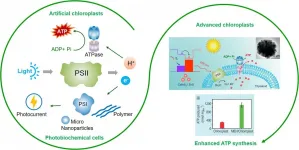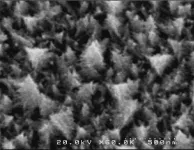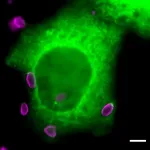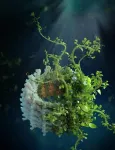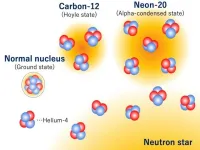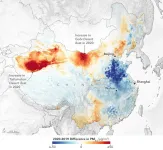Streptococcus pneumoniae sticks to dying lung cells, worsening secondary infection following flu
This novel virulence trait, which increases severity of S. pneumoniae superinfection, involves pneumococcal surface protein A, now identified as an adhesin
2021-06-24
(Press-News.org) BIRMINGHAM, Ala. - A bout with flu virus can be hard, but when Streptococcus pneumonia enters the mix, it can turn deadly.
Now researchers have found a further reason for the severity of this dual infection by identifying a new virulence mechanism for a surface protein on the pneumonia-causing bacteria S. pneumoniae. This insight comes more than three decades after discovery of that surface protein, called pneumococcal surface protein A, or PspA.
This new mechanism had been missed in the past because it facilitates bacterial adherence only to dead or dying lung epithelial cells, not to living cells. Heretofore, researchers typically used healthy lung cell monolayers to search for bacterial adhesins that aid infection. Virus killing of lung cells during flu was found to set the stage for S. pneumonia attachment to the airway, thereby worsening disease and pneumonia.
The research, published in the journal Cell Reports, was led by Carlos Orihuela, Ph.D., and David Briles, Ph.D., professor and professor emeritus in the University of Alabama at Birmingham Department of Microbiology. Orihuela and Briles say their findings provide further explanation for how an infection by influenza A flu virus -- followed by S. pneumoniae superinfection -- causes severe pneumonia and a high death rate. The mechanism also points to possible improvements for disease treatment and vaccination.
A historical example of the deadly synergy of flu infection followed by S. pneumoniae superinfection is found in banked lung samples from the 1918 Spanish influenza pandemic that killed 40 million to 50 million people -- the vast majority of these samples showed co-infection or secondary infection with S. pneumonia.
The UAB research on PspA began with some head-scratching results from experimental lung infections of mice with influenza A, followed by either wild-type S. pneumonia that has the intact PspA gene, or a mutant S. pneumoniae that lacks PspA. Lung homogenates from mice infected with the wild-type had much higher numbers of S. pneumonia bacteria than lungs infected with the mutant. However, when researchers washed the interiors of the lungs and collected that bronchoalveolar lavage fluid, they counted similar numbers of the wild-type S. pneumonia and the mutant.
"This unexpected result was interpreted to mean that wild-type S. pneumoniae were more resistant to dislodgement than S. pneumonia with a pspA gene deletion, and it served as rationale for further experimentation," Orihuela said.
From this clue, the researchers were able to show that PspA functions as an adhesin to dying host cells, in addition to its several other previously established virulence mechanisms. The researchers also detailed the molecular mechanism of this bacterial adherence.
Both influenza A infection and release of the S. pneumoniae toxin pneumolysin cause death of lung epithelial cells. As they are dying, cells' phosphatidylserine residues get flipped to the outer cell membrane, where they bind the host enzyme glyceraldehyde-3-phosphate dehydrogenase, or GAPDH. In turn, the S. pneumoniae PspA on the surface of the bacteria binds to the GAPDH. PspA-GAPDH-mediated binding to lung cells increased S. pneumoniae localization in the lower airway, and this was enhanced by pneumolysin exposure or co-infection with influenza A virus.
Tests with fragments of the PspA protein showed that a 52-amino acid portion of the protein -- from amino acid 230 to 281 -- was required for GAPDH binding. Instilling one of those binding fragments into the lungs of influenza-infected mice reduced the disease severity of S. pneumoniae superinfection, presumably through binding competition.
"Our findings support the targeting of regions of PspA for therapeutic and vaccine development against influenza A/Streptococcus pneumoniae superinfections," Orihuela said. "Importantly, and despite more than 30 years since its discovery, PspA was not previously shown to function as an adhesin. Thus, our finding of PspA's role in adherence substantially advances our knowledge on the interactions of S. pneumoniae with its host."
INFORMATION:
Besides Orihuela and Briles as co-senior authors, Sang-Sang Park and Norberto Gonzalez-Juarbe are co-first authors of the study, "Streptococcus pneumoniae binds to host GAPDH on dying lung epithelial cells worsening secondary infection following influenza." The four researchers hold a provisional patent on PspA.
Park and fellow co-authors Ashleigh N. Riegler, Hansol Im, Yvette Hale and Christina Croney are in the UAB Department of Microbiology. Gonzalez-Juarbe and Maryann P. Platt are in the Infectious Diseases and Genomic Medicine Group, J. Craig Venter Institute, Rockville, Maryland.
Support came from National Institutes of Health grants AI007051-38, AI118805 AI568898, AI146149, AI148368 and AI114800; J. Craig Venter Institute startup funds; and American Heart Association grant 16GRNT30230007.
[Attachments] See images for this press release:

ELSE PRESS RELEASES FROM THIS DATE:
2021-06-24
Ultrasound can overcome some of the detrimental effects of ageing and dementia without the need to cross the blood-brain barrier, Queensland Brain Institute researchers have found.
Professor Jürgen Götz led a multidisciplinary team at QBI's Clem Jones Centre for Ageing Dementia Research who showed low-intensity ultrasound effectively restored cognition without opening the barrier in mice models.
The findings provide a potential new avenue for the non-invasive technology and will help clinicians tailor medical treatments that consider an individual's disease progression and cognitive decline.
"Historically, ...
2021-06-24
Are the traditional practices tied to endangered species at risk of being lost? The answer is yes, according to the authors of an ethnographic study published in the University of Guam peer-reviewed journal Pacific Asia Inquiry. But the authors also say a recovery plan can protect both the species as well as the traditional CHamoru practice of consuming them.
Else Demeulenaere, lead author of the study and associate director of the UOG Center for Island Sustainability, presented on their findings during the Marianas Terrestrial Conservation Conference on June 8.
Strong ...
2021-06-24
In the recent decade, scientists have paid more attention to studying light harvest for producing novel bionic materials or integrating naturally biological components into synthetic systems. Inspiration is the imitation of natural photosynthesis in green plants, algae, and cyanobacteria to convert light energy into chemical energy. Photosystem II (PSII) is a light-intervened protein complex responsible for the light harvest and water splitting to release O2, protons, and electrons. The development of PSII-based biomimetic assembly in vitro is favorable for the investigation of photocatalysis, biological solar cells, and bionic photosynthesis, further help us reveal more secret of photosynthesis.
The combination of PSII and artificially synthetic structures is successful for ...
2021-06-24
Ishikawa, Japan - Nanostructured metal surface has novel physical and chemical properties, which have sparked scientific interest for heterogeneous catalysis, biosensors, and electrocatalysis. The fabrication process can influence the shapes and sizes of metal nanostructures. Among various fabrication processes, the electrochemical deposition technique is widely used for clean metal nanostructures. Applying the technique, a team of researchers led by Dr. Yuki Nagao, Associate Professor at Japan Advanced Institute of Science and Technology (JAIST) and Md. Mahmudul Hasan, a PhD student at JAIST, succeeded to construct Pd-based catalysts having unique morphology.
In this study, the team has successfully synthesized Christmas-tree-shaped palladium nanostructures on the GCE ...
2021-06-24
Toxoplasma gondii, the parasite responsible for toxoplasmosis, is capable of infecting almost all cell types. It is estimated that up to 30% of the world's population is chronically infected, the vast majority asymptomatically. However, infection during pregnancy can result in severe developmental pathology in the unborn child. Like the other members of the large phylum of Apicomplexa, Toxoplasma gondii is an obligate intracellular parasite which, to survive, must absolutely penetrate its host's cells and hijack their functions to its own advantage. Understanding how the parasite manages to enter host cells offers new opportunities to develop more effective prevention and control strategies than those currently available. A team from the University of Geneva (UNIGE), in collaboration ...
2021-06-24
An international study led by Helmholtz Zentrum München has revealed the structure of a membrane-remodeling protein that builds and maintains photosynthetic membranes. These fundamental insights lay the groundwork for bioengineering efforts to strengthen plants against environmental stress, helping to sustaining human food supply and fight against climate change.
Plants, algae, and cyanobacteria perform photosynthesis, using the energy of sunlight to produce the oxygen and biochemical energy that power most life on Earth. They also adsorb carbon dioxide (CO?) from the atmosphere, counteracting the accumulation of this greenhouse gas. However, climate change ...
2021-06-24
Men - more often than women - need passion to succeed at things. At the same time, boys are diagnosed as being on the autism spectrum four times as often as girls.
Both statistics may be related to dopamine, one of our body's neurotransmitters.
"This is interesting. Research shows a more active dopamine system in most men" than in women, says Hermundur Sigmundsson, a professor at the Norwegian University of Science and Technology's (NTNU)Department of Psychology.
He is behind a new study that addresses gender differences in key motivating factors for what it takes to become good at something. The study uses men's and women's differing activity in the dopamine system as an explanatory model.
"We looked at gender differences around passion, self-discipline ...
2021-06-24
Researchers from Skoltech and their colleagues have shown that adaptation to similar environments hardly involves similar genomic positions when species are distantly related. The team investigated recurrent adaptations of wildlife birds' mitochondria to high altitude, migration, diving, wintering, and flight. Repeatable substitutions are rather a coincidence than adaptation, which confirms the scientific opinion that distant species "choose" different ways of similar trait evolution. The paper was published in the journal Genome Biology and Evolution.
If an organism wants to survive in unusual conditions, such as oxygen starvation typical for high altitudes or elevation of metabolism rate due to extreme temperatures, it has to adapt. If different species meet similar environment ...
2021-06-24
Osaka, Japan - Scientists from the Department of Physics and the Research Center for Nuclear Physics (RCNP) at Osaka University, in collaboration with Kyoto University, used alpha particle inelastic scattering to show that the theorized "5α condensed state" does exist in neon-20. This work may help us obtain a better understanding the low-density nucleon many-body systems.
All elements besides hydrogen and helium must have been fused inside the nuclear furnace of a star. The yield during these reactions of carbon-12, which has six protons and six neutrons, is increased by an ...
2021-06-24
Early in the pandemic, it was expected that satellite imagery around the world would show cleaner air as a result of COVID-19 lockdowns. But not all pollutants were taken out of circulation. For tiny airborne-particle pollution, known as PM 2.5, researchers using NASA data found that variability from meteorology obscured the lockdown signals when observed from space.
"Intuitively you would think if there is a major lockdown situation, that we would see dramatic changes, but we didn't," said Melanie Hammer, a visiting research associate at Washington University in St. Louis who led the study. "It was kind of a surprise ...
LAST 30 PRESS RELEASES:
[Press-News.org] Streptococcus pneumoniae sticks to dying lung cells, worsening secondary infection following flu
This novel virulence trait, which increases severity of S. pneumoniae superinfection, involves pneumococcal surface protein A, now identified as an adhesin



